Holmes Institute HI5017: Managerial Accounting System Analysis Report
VerifiedAdded on 2022/10/17
|11
|3680
|13
Report
AI Summary
This report provides an executive summary of Managerial Accounting Systems (MAS), analyzing its evolution and contemporary applications. It examines two journal articles to evaluate MAS methods like Activity-Based Costing (ABC), Just-In-Time (JIT), and Balanced Scorecards, highlighting their relevance in real-world business scenarios. The report discusses the importance of MAS in decision-making, especially in uncertain business environments, and compares the use of MAS in different organizational contexts. It emphasizes the significance of MAS in achieving business goals and outlines specific outcomes related to cost reduction, performance management, and strategic decision-making. The report also investigates the factors influencing the successful implementation of MAS and its impact on organizational performance.
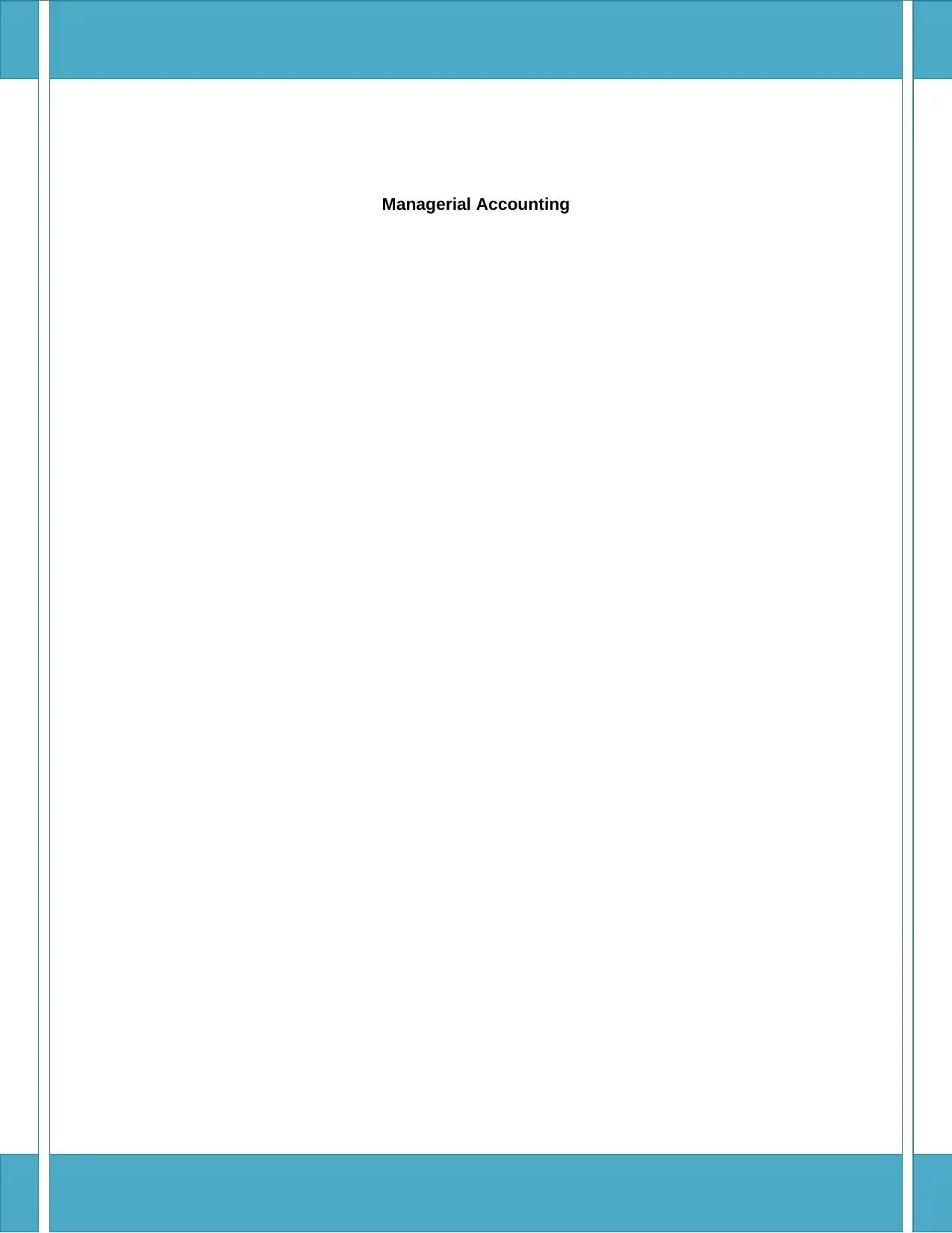
Managerial Accounting
Paraphrase This Document
Need a fresh take? Get an instant paraphrase of this document with our AI Paraphraser

MAS
Executive Summary
With the due passage of time management style has undergone a sea change and hence, the
management accounting system changed for the better. The traditional accounting system is
rarely seen in the current scenario and is replaced by the new management accounting
system. Contemporary accounting system such as TQM, BSC, and JIT has assumed a place
of special importance owing to the flexibility and being result-oriented. The current report is
based upon the Management Accounting system and to conduct the study two articles about
MAS has been undertaken. The report initiates with the introduction followed by the
application of MAS in the organization. In the end, the outcomes are discussed in the light of
both the organization
2
Executive Summary
With the due passage of time management style has undergone a sea change and hence, the
management accounting system changed for the better. The traditional accounting system is
rarely seen in the current scenario and is replaced by the new management accounting
system. Contemporary accounting system such as TQM, BSC, and JIT has assumed a place
of special importance owing to the flexibility and being result-oriented. The current report is
based upon the Management Accounting system and to conduct the study two articles about
MAS has been undertaken. The report initiates with the introduction followed by the
application of MAS in the organization. In the end, the outcomes are discussed in the light of
both the organization
2

MAS
Contents
Introduction...........................................................................................................................................................3
1. Management Accounting methods/ techniques used in the 1 article or study..................................................3
2. MAS Relevancy in contemporary organizations.................................................................................................4
i. Evidence from the case study.........................................................................................................................4
ii. Comparison with the second study................................................................................................................5
3. Relevancy of MAS in an uncertain business environment..................................................................................6
4. Specific outcomes...............................................................................................................................................6
Conclusion..............................................................................................................................................................8
References..............................................................................................................................................................9
3
Contents
Introduction...........................................................................................................................................................3
1. Management Accounting methods/ techniques used in the 1 article or study..................................................3
2. MAS Relevancy in contemporary organizations.................................................................................................4
i. Evidence from the case study.........................................................................................................................4
ii. Comparison with the second study................................................................................................................5
3. Relevancy of MAS in an uncertain business environment..................................................................................6
4. Specific outcomes...............................................................................................................................................6
Conclusion..............................................................................................................................................................8
References..............................................................................................................................................................9
3
⊘ This is a preview!⊘
Do you want full access?
Subscribe today to unlock all pages.

Trusted by 1+ million students worldwide
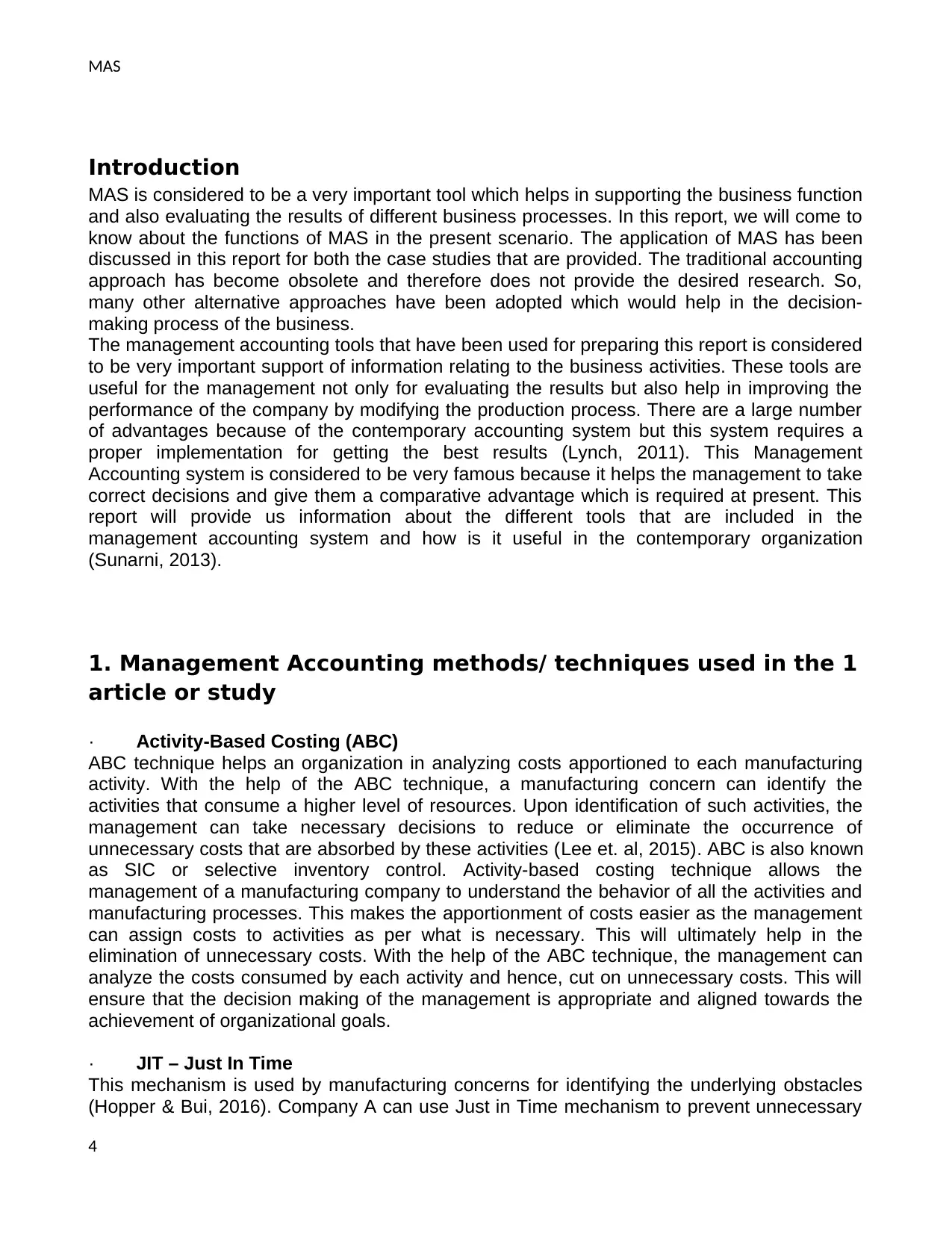
MAS
Introduction
MAS is considered to be a very important tool which helps in supporting the business function
and also evaluating the results of different business processes. In this report, we will come to
know about the functions of MAS in the present scenario. The application of MAS has been
discussed in this report for both the case studies that are provided. The traditional accounting
approach has become obsolete and therefore does not provide the desired research. So,
many other alternative approaches have been adopted which would help in the decision-
making process of the business.
The management accounting tools that have been used for preparing this report is considered
to be very important support of information relating to the business activities. These tools are
useful for the management not only for evaluating the results but also help in improving the
performance of the company by modifying the production process. There are a large number
of advantages because of the contemporary accounting system but this system requires a
proper implementation for getting the best results (Lynch, 2011). This Management
Accounting system is considered to be very famous because it helps the management to take
correct decisions and give them a comparative advantage which is required at present. This
report will provide us information about the different tools that are included in the
management accounting system and how is it useful in the contemporary organization
(Sunarni, 2013).
1. Management Accounting methods/ techniques used in the 1
article or study
· Activity-Based Costing (ABC)
ABC technique helps an organization in analyzing costs apportioned to each manufacturing
activity. With the help of the ABC technique, a manufacturing concern can identify the
activities that consume a higher level of resources. Upon identification of such activities, the
management can take necessary decisions to reduce or eliminate the occurrence of
unnecessary costs that are absorbed by these activities (Lee et. al, 2015). ABC is also known
as SIC or selective inventory control. Activity-based costing technique allows the
management of a manufacturing company to understand the behavior of all the activities and
manufacturing processes. This makes the apportionment of costs easier as the management
can assign costs to activities as per what is necessary. This will ultimately help in the
elimination of unnecessary costs. With the help of the ABC technique, the management can
analyze the costs consumed by each activity and hence, cut on unnecessary costs. This will
ensure that the decision making of the management is appropriate and aligned towards the
achievement of organizational goals.
· JIT – Just In Time
This mechanism is used by manufacturing concerns for identifying the underlying obstacles
(Hopper & Bui, 2016). Company A can use Just in Time mechanism to prevent unnecessary
4
Introduction
MAS is considered to be a very important tool which helps in supporting the business function
and also evaluating the results of different business processes. In this report, we will come to
know about the functions of MAS in the present scenario. The application of MAS has been
discussed in this report for both the case studies that are provided. The traditional accounting
approach has become obsolete and therefore does not provide the desired research. So,
many other alternative approaches have been adopted which would help in the decision-
making process of the business.
The management accounting tools that have been used for preparing this report is considered
to be very important support of information relating to the business activities. These tools are
useful for the management not only for evaluating the results but also help in improving the
performance of the company by modifying the production process. There are a large number
of advantages because of the contemporary accounting system but this system requires a
proper implementation for getting the best results (Lynch, 2011). This Management
Accounting system is considered to be very famous because it helps the management to take
correct decisions and give them a comparative advantage which is required at present. This
report will provide us information about the different tools that are included in the
management accounting system and how is it useful in the contemporary organization
(Sunarni, 2013).
1. Management Accounting methods/ techniques used in the 1
article or study
· Activity-Based Costing (ABC)
ABC technique helps an organization in analyzing costs apportioned to each manufacturing
activity. With the help of the ABC technique, a manufacturing concern can identify the
activities that consume a higher level of resources. Upon identification of such activities, the
management can take necessary decisions to reduce or eliminate the occurrence of
unnecessary costs that are absorbed by these activities (Lee et. al, 2015). ABC is also known
as SIC or selective inventory control. Activity-based costing technique allows the
management of a manufacturing company to understand the behavior of all the activities and
manufacturing processes. This makes the apportionment of costs easier as the management
can assign costs to activities as per what is necessary. This will ultimately help in the
elimination of unnecessary costs. With the help of the ABC technique, the management can
analyze the costs consumed by each activity and hence, cut on unnecessary costs. This will
ensure that the decision making of the management is appropriate and aligned towards the
achievement of organizational goals.
· JIT – Just In Time
This mechanism is used by manufacturing concerns for identifying the underlying obstacles
(Hopper & Bui, 2016). Company A can use Just in Time mechanism to prevent unnecessary
4
Paraphrase This Document
Need a fresh take? Get an instant paraphrase of this document with our AI Paraphraser

MAS
use of inventories and smoothen out its manufacturing activities when there is a deficiency
detected in the operations. Just in time mechanism was taken into use by organizations to
improve its inventory turnover and reduce or eliminate the occurrence of unnecessary costs.
With the help of Just in time mechanism organizations can prevent unnecessary costs from
taking place.
· Balance Scorecard
Balanced scorecard approach allows the management to track the performance of the
employees. It is a very important tool of performance management where the activities of the
employees can be tracked and accordingly regulated. It also helps in evaluating the activities
which may arise from various actions (Surumm, 2017). The manufacturing company has
implemented a balanced scorecard approach but the same was rejected as the scope of
complexity in the company was hardly there. The approach will not add any utility to any
manufacturing concern that has a very simple way of functioning. The technique does not
offer any benefits to companies that are very simple in its approach. Hence, this is why the
company rejected the balanced scorecard method over some time.
2. MAS Relevancy in contemporary organizations
i. Evidence from the case study
The decisions made by the management of the organization seem flawless. The management
has always ensured that the decisions that are being taken by them are completely in the best
interest of the organization. The company’s management is responsible enough in fulfilling
their responsibilities. The management is completely in sync with one other at all levels. The
senior management of the company is charged with the responsibility of making strategic
decisions and the lower level management is required to make operational decisions. The
middle-level managers are charged with the responsibility of making tactical decisions. The
level of involvement of lower-level management with the Management Accounting System
(MAS) is way higher than the senior and middle-level management. All the levels of
management are highly inter-dependent on one other and therefore, they must work in
complete sync so that there is minimal scope for miscommunication (Watts, Yapa &
Dellaportas, 2014). Each managerial department is important for the survival of an
organization and therefore, it must be ensured that is no scope for complexes.
Operational Level
Management Accounting System is largely used by the operational level or lower-level
management for making operational decisions. At an operation level, various decisions are
being taken concerning purchases and production. Hence, the use of Management
Accounting System techniques comes into foreplay. While making purchase-related orders, it
becomes important for the management to evaluate minimum order quantities. Management
Accounting System techniques allows the management to calculate MOQ for evaluating the
purchase orders that need to be placed. Various operational decisions can be taken with the
help of MAS techniques (Watts, Yapa & Dellaportas, 2014). The lower level management of
the organization has used Benchmarking technique instead of ABC and ABM since these
didn’t seem useful at all.
5
use of inventories and smoothen out its manufacturing activities when there is a deficiency
detected in the operations. Just in time mechanism was taken into use by organizations to
improve its inventory turnover and reduce or eliminate the occurrence of unnecessary costs.
With the help of Just in time mechanism organizations can prevent unnecessary costs from
taking place.
· Balance Scorecard
Balanced scorecard approach allows the management to track the performance of the
employees. It is a very important tool of performance management where the activities of the
employees can be tracked and accordingly regulated. It also helps in evaluating the activities
which may arise from various actions (Surumm, 2017). The manufacturing company has
implemented a balanced scorecard approach but the same was rejected as the scope of
complexity in the company was hardly there. The approach will not add any utility to any
manufacturing concern that has a very simple way of functioning. The technique does not
offer any benefits to companies that are very simple in its approach. Hence, this is why the
company rejected the balanced scorecard method over some time.
2. MAS Relevancy in contemporary organizations
i. Evidence from the case study
The decisions made by the management of the organization seem flawless. The management
has always ensured that the decisions that are being taken by them are completely in the best
interest of the organization. The company’s management is responsible enough in fulfilling
their responsibilities. The management is completely in sync with one other at all levels. The
senior management of the company is charged with the responsibility of making strategic
decisions and the lower level management is required to make operational decisions. The
middle-level managers are charged with the responsibility of making tactical decisions. The
level of involvement of lower-level management with the Management Accounting System
(MAS) is way higher than the senior and middle-level management. All the levels of
management are highly inter-dependent on one other and therefore, they must work in
complete sync so that there is minimal scope for miscommunication (Watts, Yapa &
Dellaportas, 2014). Each managerial department is important for the survival of an
organization and therefore, it must be ensured that is no scope for complexes.
Operational Level
Management Accounting System is largely used by the operational level or lower-level
management for making operational decisions. At an operation level, various decisions are
being taken concerning purchases and production. Hence, the use of Management
Accounting System techniques comes into foreplay. While making purchase-related orders, it
becomes important for the management to evaluate minimum order quantities. Management
Accounting System techniques allows the management to calculate MOQ for evaluating the
purchase orders that need to be placed. Various operational decisions can be taken with the
help of MAS techniques (Watts, Yapa & Dellaportas, 2014). The lower level management of
the organization has used Benchmarking technique instead of ABC and ABM since these
didn’t seem useful at all.
5

MAS
The management at the middle level is responsible for making tactical decisions and this is
why they are not always required to use MAS. The tactical decisions taken by the middle-level
management is based on certain information that is received in numerous formats and not all
MAS formats fit into the case (Peirson et. al, 2015). The relevance of MAS is lesser at the
middle-level management. Middle-level management is responsible for taking both
operational and strategic decisions. The managers at the middle level must take both internal
and external information into consideration while making tactical decisions. Middle-level
management is highly concerned about the demand and supply of the products manufactured
in the organization. This is why the relevance of MAS at this level is lower as compared to
lower-level management (Watts, Yapa & Dellaportas, 2014).
The relevance of MAS is just negligible at the top-level of management. The senior
management is concerned with making strategic decisions for which they highly rely on
external information. The strategic decisions taken by senior management is used by
investors, employees, creditors, suppliers, and directors. Senior management makes strategic
decisions based on external information mainly. The use of MAS information is negligible at
the top-level management since the strategic decisions taken at this level are based on
external information like global trends, etc (Phua , Abernethy & Lillis, 2011)
To conclude, it can be said that the utility of MAS information is highly dependent upon its
implementation in an organization.
ii. Comparison with the second study
In the first study, the contemporary tools of management are given due emphasis such as
ABC, Value chain, JIT, TQM, etc. the study provides a strong insight that the techniques have
gained immense attention and popularity. Further, the application of the MAS in organization
A has been described and that remains a composite of different tools such as ABC, Balance
scorecard and JIT, etc.
On the other hand, in the second case study, the study stress upon the link between the
structure of the MAS, management style and the impact on the performance of the
organization. The relationship between the variables has been defined and studied within the
domain of the public healthcare sector. In this study, the MAS vs. the traditional accounting
system has been undertaken to provide a better depth of study. The collection of data for the
study is done from the public hospitals and a comprehensive study has been done in this
regard. The tool of the management accounting system that has been studied in the paper is
that of balance scorecard whereas in the first case study different tools of MAS have been
projected. This case study is more inclined towards the implementation of MAS together with
the performance indicators that reflect the external environment and is future-oriented.
Thereby, the article stresses the fact that it is not only about the appropriate information but
also concerns the design of the MAS. It is a vital factor that helps the organization to derive
more value from the top to the bottom line. The article is different from the first article
because, in this scenario, the MAS discussion is regarding the functionality of the overall
organization. To this effect, the management style is an important consideration that plays a
leading role. Therefore, the article does not have a major reliance or discussion on a
particular management accounting system rather discusses more of style and the
implementation factor.
The similarity that can be noted in both the article consists of enhancing the performances. As
per the articles, it can be commented that the management is more concerned with the quality
6
The management at the middle level is responsible for making tactical decisions and this is
why they are not always required to use MAS. The tactical decisions taken by the middle-level
management is based on certain information that is received in numerous formats and not all
MAS formats fit into the case (Peirson et. al, 2015). The relevance of MAS is lesser at the
middle-level management. Middle-level management is responsible for taking both
operational and strategic decisions. The managers at the middle level must take both internal
and external information into consideration while making tactical decisions. Middle-level
management is highly concerned about the demand and supply of the products manufactured
in the organization. This is why the relevance of MAS at this level is lower as compared to
lower-level management (Watts, Yapa & Dellaportas, 2014).
The relevance of MAS is just negligible at the top-level of management. The senior
management is concerned with making strategic decisions for which they highly rely on
external information. The strategic decisions taken by senior management is used by
investors, employees, creditors, suppliers, and directors. Senior management makes strategic
decisions based on external information mainly. The use of MAS information is negligible at
the top-level management since the strategic decisions taken at this level are based on
external information like global trends, etc (Phua , Abernethy & Lillis, 2011)
To conclude, it can be said that the utility of MAS information is highly dependent upon its
implementation in an organization.
ii. Comparison with the second study
In the first study, the contemporary tools of management are given due emphasis such as
ABC, Value chain, JIT, TQM, etc. the study provides a strong insight that the techniques have
gained immense attention and popularity. Further, the application of the MAS in organization
A has been described and that remains a composite of different tools such as ABC, Balance
scorecard and JIT, etc.
On the other hand, in the second case study, the study stress upon the link between the
structure of the MAS, management style and the impact on the performance of the
organization. The relationship between the variables has been defined and studied within the
domain of the public healthcare sector. In this study, the MAS vs. the traditional accounting
system has been undertaken to provide a better depth of study. The collection of data for the
study is done from the public hospitals and a comprehensive study has been done in this
regard. The tool of the management accounting system that has been studied in the paper is
that of balance scorecard whereas in the first case study different tools of MAS have been
projected. This case study is more inclined towards the implementation of MAS together with
the performance indicators that reflect the external environment and is future-oriented.
Thereby, the article stresses the fact that it is not only about the appropriate information but
also concerns the design of the MAS. It is a vital factor that helps the organization to derive
more value from the top to the bottom line. The article is different from the first article
because, in this scenario, the MAS discussion is regarding the functionality of the overall
organization. To this effect, the management style is an important consideration that plays a
leading role. Therefore, the article does not have a major reliance or discussion on a
particular management accounting system rather discusses more of style and the
implementation factor.
The similarity that can be noted in both the article consists of enhancing the performances. As
per the articles, it can be commented that the management is more concerned with the quality
6
⊘ This is a preview!⊘
Do you want full access?
Subscribe today to unlock all pages.

Trusted by 1+ million students worldwide
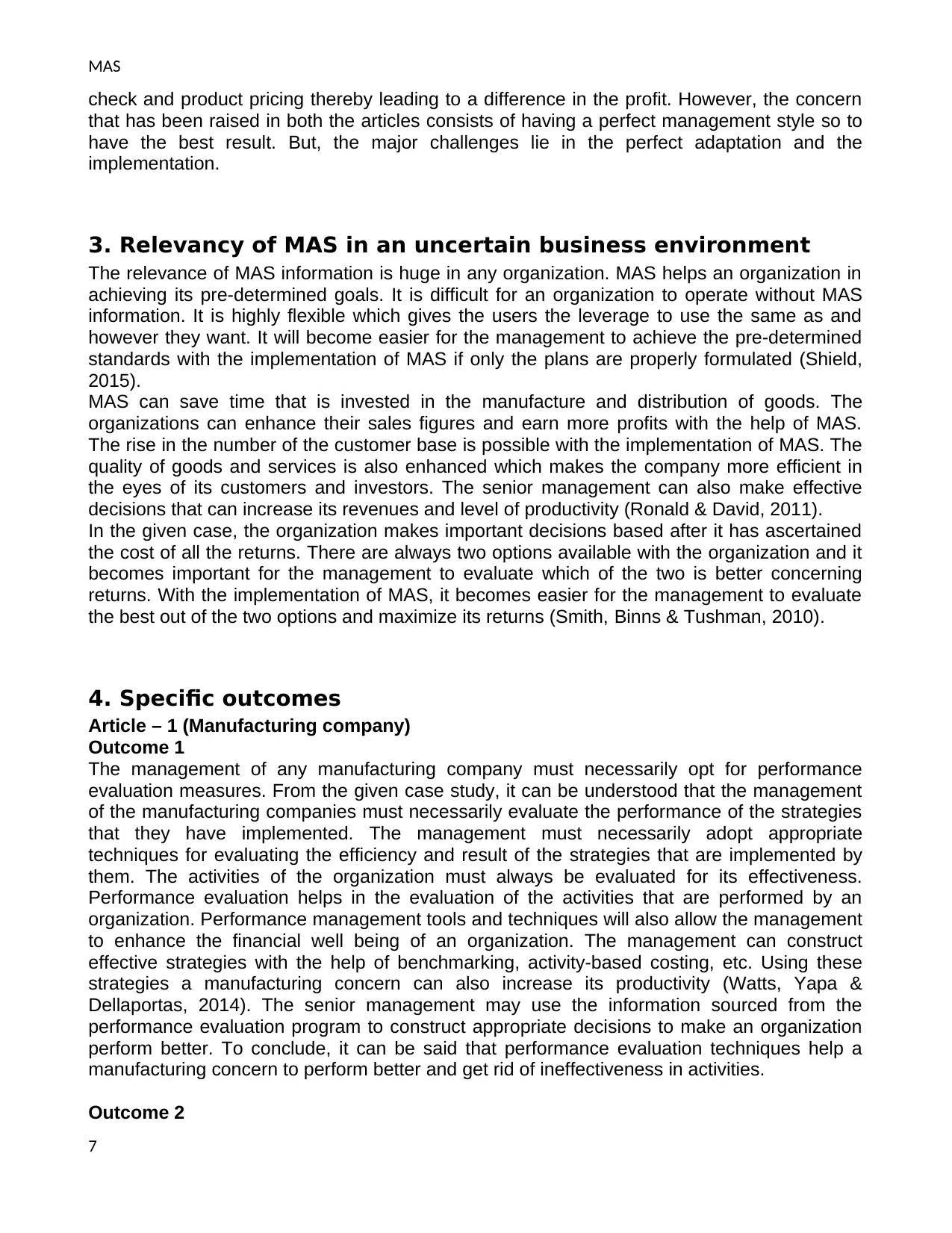
MAS
check and product pricing thereby leading to a difference in the profit. However, the concern
that has been raised in both the articles consists of having a perfect management style so to
have the best result. But, the major challenges lie in the perfect adaptation and the
implementation.
3. Relevancy of MAS in an uncertain business environment
The relevance of MAS information is huge in any organization. MAS helps an organization in
achieving its pre-determined goals. It is difficult for an organization to operate without MAS
information. It is highly flexible which gives the users the leverage to use the same as and
however they want. It will become easier for the management to achieve the pre-determined
standards with the implementation of MAS if only the plans are properly formulated (Shield,
2015).
MAS can save time that is invested in the manufacture and distribution of goods. The
organizations can enhance their sales figures and earn more profits with the help of MAS.
The rise in the number of the customer base is possible with the implementation of MAS. The
quality of goods and services is also enhanced which makes the company more efficient in
the eyes of its customers and investors. The senior management can also make effective
decisions that can increase its revenues and level of productivity (Ronald & David, 2011).
In the given case, the organization makes important decisions based after it has ascertained
the cost of all the returns. There are always two options available with the organization and it
becomes important for the management to evaluate which of the two is better concerning
returns. With the implementation of MAS, it becomes easier for the management to evaluate
the best out of the two options and maximize its returns (Smith, Binns & Tushman, 2010).
4. Specific outcomes
Article – 1 (Manufacturing company)
Outcome 1
The management of any manufacturing company must necessarily opt for performance
evaluation measures. From the given case study, it can be understood that the management
of the manufacturing companies must necessarily evaluate the performance of the strategies
that they have implemented. The management must necessarily adopt appropriate
techniques for evaluating the efficiency and result of the strategies that are implemented by
them. The activities of the organization must always be evaluated for its effectiveness.
Performance evaluation helps in the evaluation of the activities that are performed by an
organization. Performance management tools and techniques will also allow the management
to enhance the financial well being of an organization. The management can construct
effective strategies with the help of benchmarking, activity-based costing, etc. Using these
strategies a manufacturing concern can also increase its productivity (Watts, Yapa &
Dellaportas, 2014). The senior management may use the information sourced from the
performance evaluation program to construct appropriate decisions to make an organization
perform better. To conclude, it can be said that performance evaluation techniques help a
manufacturing concern to perform better and get rid of ineffectiveness in activities.
Outcome 2
7
check and product pricing thereby leading to a difference in the profit. However, the concern
that has been raised in both the articles consists of having a perfect management style so to
have the best result. But, the major challenges lie in the perfect adaptation and the
implementation.
3. Relevancy of MAS in an uncertain business environment
The relevance of MAS information is huge in any organization. MAS helps an organization in
achieving its pre-determined goals. It is difficult for an organization to operate without MAS
information. It is highly flexible which gives the users the leverage to use the same as and
however they want. It will become easier for the management to achieve the pre-determined
standards with the implementation of MAS if only the plans are properly formulated (Shield,
2015).
MAS can save time that is invested in the manufacture and distribution of goods. The
organizations can enhance their sales figures and earn more profits with the help of MAS.
The rise in the number of the customer base is possible with the implementation of MAS. The
quality of goods and services is also enhanced which makes the company more efficient in
the eyes of its customers and investors. The senior management can also make effective
decisions that can increase its revenues and level of productivity (Ronald & David, 2011).
In the given case, the organization makes important decisions based after it has ascertained
the cost of all the returns. There are always two options available with the organization and it
becomes important for the management to evaluate which of the two is better concerning
returns. With the implementation of MAS, it becomes easier for the management to evaluate
the best out of the two options and maximize its returns (Smith, Binns & Tushman, 2010).
4. Specific outcomes
Article – 1 (Manufacturing company)
Outcome 1
The management of any manufacturing company must necessarily opt for performance
evaluation measures. From the given case study, it can be understood that the management
of the manufacturing companies must necessarily evaluate the performance of the strategies
that they have implemented. The management must necessarily adopt appropriate
techniques for evaluating the efficiency and result of the strategies that are implemented by
them. The activities of the organization must always be evaluated for its effectiveness.
Performance evaluation helps in the evaluation of the activities that are performed by an
organization. Performance management tools and techniques will also allow the management
to enhance the financial well being of an organization. The management can construct
effective strategies with the help of benchmarking, activity-based costing, etc. Using these
strategies a manufacturing concern can also increase its productivity (Watts, Yapa &
Dellaportas, 2014). The senior management may use the information sourced from the
performance evaluation program to construct appropriate decisions to make an organization
perform better. To conclude, it can be said that performance evaluation techniques help a
manufacturing concern to perform better and get rid of ineffectiveness in activities.
Outcome 2
7
Paraphrase This Document
Need a fresh take? Get an instant paraphrase of this document with our AI Paraphraser
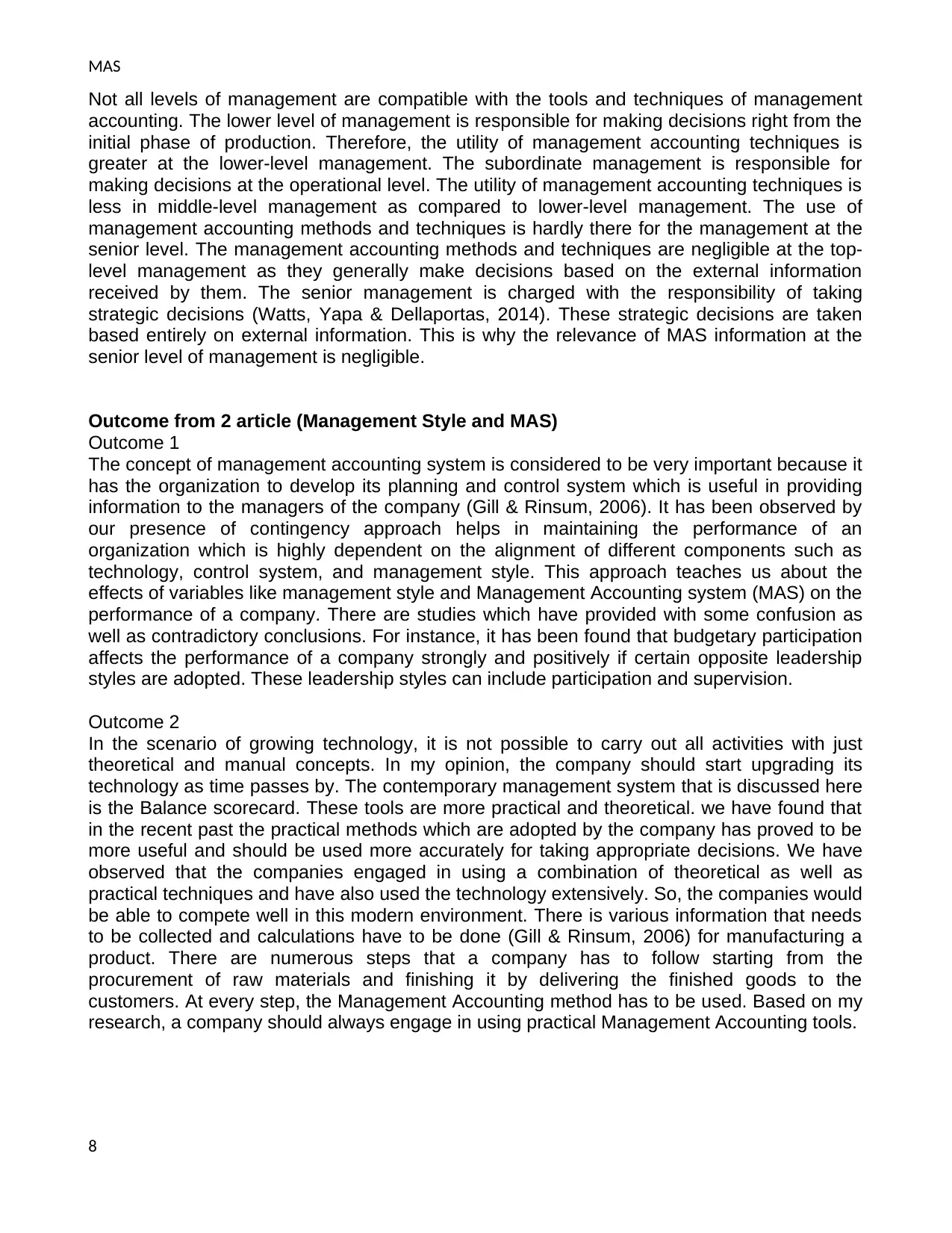
MAS
Not all levels of management are compatible with the tools and techniques of management
accounting. The lower level of management is responsible for making decisions right from the
initial phase of production. Therefore, the utility of management accounting techniques is
greater at the lower-level management. The subordinate management is responsible for
making decisions at the operational level. The utility of management accounting techniques is
less in middle-level management as compared to lower-level management. The use of
management accounting methods and techniques is hardly there for the management at the
senior level. The management accounting methods and techniques are negligible at the top-
level management as they generally make decisions based on the external information
received by them. The senior management is charged with the responsibility of taking
strategic decisions (Watts, Yapa & Dellaportas, 2014). These strategic decisions are taken
based entirely on external information. This is why the relevance of MAS information at the
senior level of management is negligible.
Outcome from 2 article (Management Style and MAS)
Outcome 1
The concept of management accounting system is considered to be very important because it
has the organization to develop its planning and control system which is useful in providing
information to the managers of the company (Gill & Rinsum, 2006). It has been observed by
our presence of contingency approach helps in maintaining the performance of an
organization which is highly dependent on the alignment of different components such as
technology, control system, and management style. This approach teaches us about the
effects of variables like management style and Management Accounting system (MAS) on the
performance of a company. There are studies which have provided with some confusion as
well as contradictory conclusions. For instance, it has been found that budgetary participation
affects the performance of a company strongly and positively if certain opposite leadership
styles are adopted. These leadership styles can include participation and supervision.
Outcome 2
In the scenario of growing technology, it is not possible to carry out all activities with just
theoretical and manual concepts. In my opinion, the company should start upgrading its
technology as time passes by. The contemporary management system that is discussed here
is the Balance scorecard. These tools are more practical and theoretical. we have found that
in the recent past the practical methods which are adopted by the company has proved to be
more useful and should be used more accurately for taking appropriate decisions. We have
observed that the companies engaged in using a combination of theoretical as well as
practical techniques and have also used the technology extensively. So, the companies would
be able to compete well in this modern environment. There is various information that needs
to be collected and calculations have to be done (Gill & Rinsum, 2006) for manufacturing a
product. There are numerous steps that a company has to follow starting from the
procurement of raw materials and finishing it by delivering the finished goods to the
customers. At every step, the Management Accounting method has to be used. Based on my
research, a company should always engage in using practical Management Accounting tools.
8
Not all levels of management are compatible with the tools and techniques of management
accounting. The lower level of management is responsible for making decisions right from the
initial phase of production. Therefore, the utility of management accounting techniques is
greater at the lower-level management. The subordinate management is responsible for
making decisions at the operational level. The utility of management accounting techniques is
less in middle-level management as compared to lower-level management. The use of
management accounting methods and techniques is hardly there for the management at the
senior level. The management accounting methods and techniques are negligible at the top-
level management as they generally make decisions based on the external information
received by them. The senior management is charged with the responsibility of taking
strategic decisions (Watts, Yapa & Dellaportas, 2014). These strategic decisions are taken
based entirely on external information. This is why the relevance of MAS information at the
senior level of management is negligible.
Outcome from 2 article (Management Style and MAS)
Outcome 1
The concept of management accounting system is considered to be very important because it
has the organization to develop its planning and control system which is useful in providing
information to the managers of the company (Gill & Rinsum, 2006). It has been observed by
our presence of contingency approach helps in maintaining the performance of an
organization which is highly dependent on the alignment of different components such as
technology, control system, and management style. This approach teaches us about the
effects of variables like management style and Management Accounting system (MAS) on the
performance of a company. There are studies which have provided with some confusion as
well as contradictory conclusions. For instance, it has been found that budgetary participation
affects the performance of a company strongly and positively if certain opposite leadership
styles are adopted. These leadership styles can include participation and supervision.
Outcome 2
In the scenario of growing technology, it is not possible to carry out all activities with just
theoretical and manual concepts. In my opinion, the company should start upgrading its
technology as time passes by. The contemporary management system that is discussed here
is the Balance scorecard. These tools are more practical and theoretical. we have found that
in the recent past the practical methods which are adopted by the company has proved to be
more useful and should be used more accurately for taking appropriate decisions. We have
observed that the companies engaged in using a combination of theoretical as well as
practical techniques and have also used the technology extensively. So, the companies would
be able to compete well in this modern environment. There is various information that needs
to be collected and calculations have to be done (Gill & Rinsum, 2006) for manufacturing a
product. There are numerous steps that a company has to follow starting from the
procurement of raw materials and finishing it by delivering the finished goods to the
customers. At every step, the Management Accounting method has to be used. Based on my
research, a company should always engage in using practical Management Accounting tools.
8
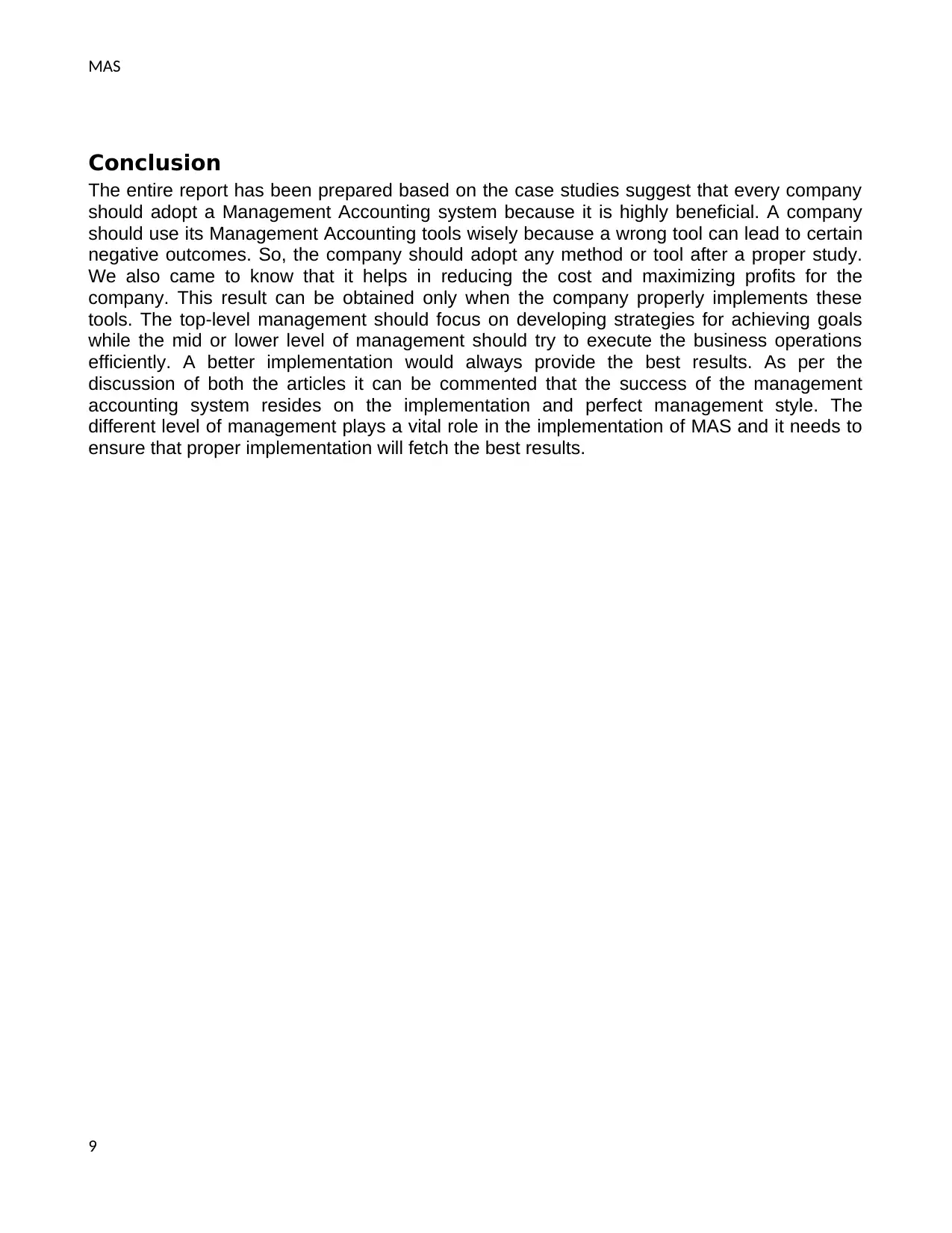
MAS
Conclusion
The entire report has been prepared based on the case studies suggest that every company
should adopt a Management Accounting system because it is highly beneficial. A company
should use its Management Accounting tools wisely because a wrong tool can lead to certain
negative outcomes. So, the company should adopt any method or tool after a proper study.
We also came to know that it helps in reducing the cost and maximizing profits for the
company. This result can be obtained only when the company properly implements these
tools. The top-level management should focus on developing strategies for achieving goals
while the mid or lower level of management should try to execute the business operations
efficiently. A better implementation would always provide the best results. As per the
discussion of both the articles it can be commented that the success of the management
accounting system resides on the implementation and perfect management style. The
different level of management plays a vital role in the implementation of MAS and it needs to
ensure that proper implementation will fetch the best results.
9
Conclusion
The entire report has been prepared based on the case studies suggest that every company
should adopt a Management Accounting system because it is highly beneficial. A company
should use its Management Accounting tools wisely because a wrong tool can lead to certain
negative outcomes. So, the company should adopt any method or tool after a proper study.
We also came to know that it helps in reducing the cost and maximizing profits for the
company. This result can be obtained only when the company properly implements these
tools. The top-level management should focus on developing strategies for achieving goals
while the mid or lower level of management should try to execute the business operations
efficiently. A better implementation would always provide the best results. As per the
discussion of both the articles it can be commented that the success of the management
accounting system resides on the implementation and perfect management style. The
different level of management plays a vital role in the implementation of MAS and it needs to
ensure that proper implementation will fetch the best results.
9
⊘ This is a preview!⊘
Do you want full access?
Subscribe today to unlock all pages.

Trusted by 1+ million students worldwide
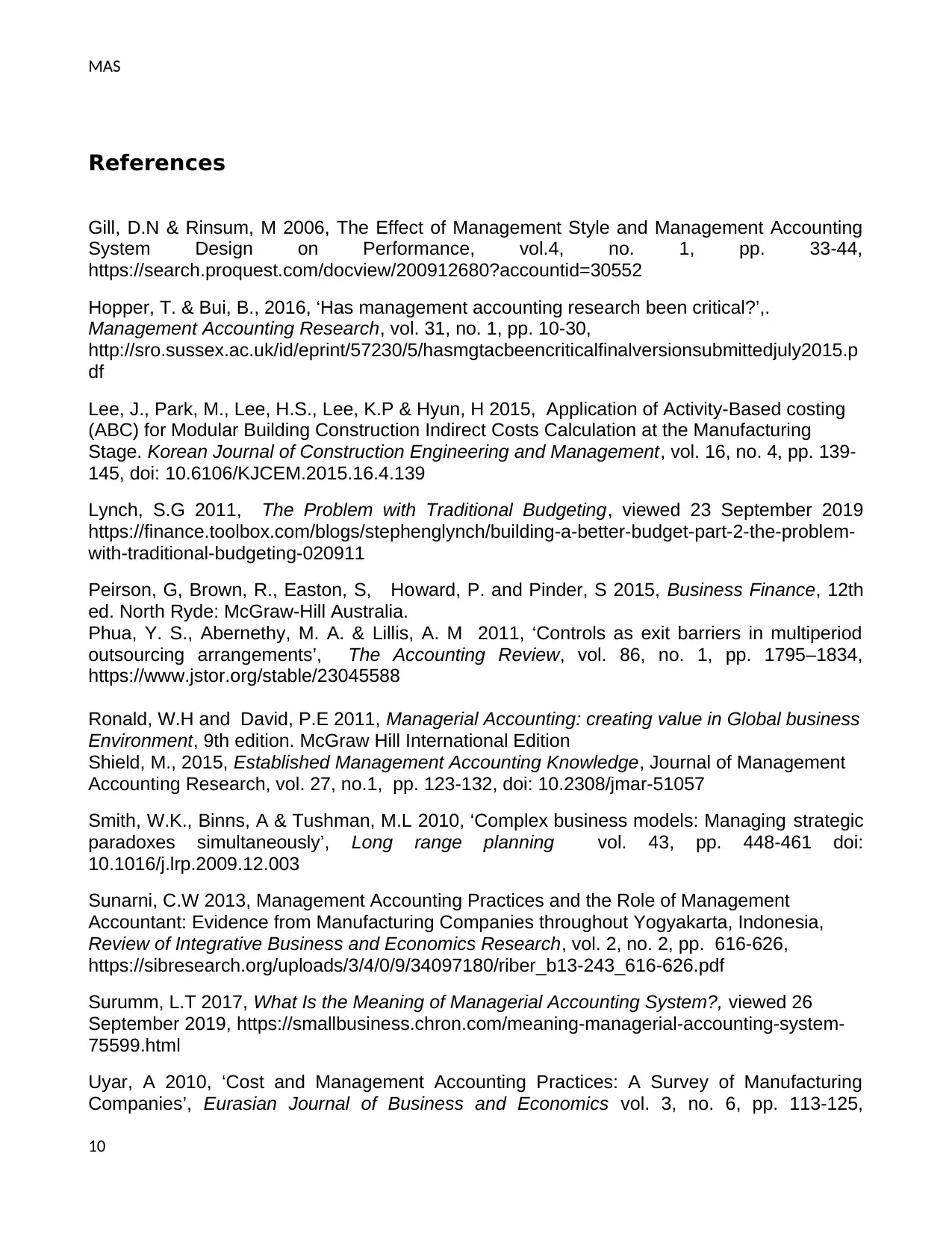
MAS
References
Gill, D.N & Rinsum, M 2006, The Effect of Management Style and Management Accounting
System Design on Performance, vol.4, no. 1, pp. 33-44,
https://search.proquest.com/docview/200912680?accountid=30552
Hopper, T. & Bui, B., 2016, ‘Has management accounting research been critical?’,.
Management Accounting Research, vol. 31, no. 1, pp. 10-30,
http://sro.sussex.ac.uk/id/eprint/57230/5/hasmgtacbeencriticalfinalversionsubmittedjuly2015.p
df
Lee, J., Park, M., Lee, H.S., Lee, K.P & Hyun, H 2015, Application of Activity-Based costing
(ABC) for Modular Building Construction Indirect Costs Calculation at the Manufacturing
Stage. Korean Journal of Construction Engineering and Management, vol. 16, no. 4, pp. 139-
145, doi: 10.6106/KJCEM.2015.16.4.139
Lynch, S.G 2011, The Problem with Traditional Budgeting, viewed 23 September 2019
https://finance.toolbox.com/blogs/stephenglynch/building-a-better-budget-part-2-the-problem-
with-traditional-budgeting-020911
Peirson, G, Brown, R., Easton, S, Howard, P. and Pinder, S 2015, Business Finance, 12th
ed. North Ryde: McGraw-Hill Australia.
Phua, Y. S., Abernethy, M. A. & Lillis, A. M 2011, ‘Controls as exit barriers in multiperiod
outsourcing arrangements’, The Accounting Review, vol. 86, no. 1, pp. 1795–1834,
https://www.jstor.org/stable/23045588
Ronald, W.H and David, P.E 2011, Managerial Accounting: creating value in Global business
Environment, 9th edition. McGraw Hill International Edition
Shield, M., 2015, Established Management Accounting Knowledge, Journal of Management
Accounting Research, vol. 27, no.1, pp. 123-132, doi: 10.2308/jmar-51057
Smith, W.K., Binns, A & Tushman, M.L 2010, ‘Complex business models: Managing strategic
paradoxes simultaneously’, Long range planning vol. 43, pp. 448-461 doi:
10.1016/j.lrp.2009.12.003
Sunarni, C.W 2013, Management Accounting Practices and the Role of Management
Accountant: Evidence from Manufacturing Companies throughout Yogyakarta, Indonesia,
Review of Integrative Business and Economics Research, vol. 2, no. 2, pp. 616-626,
https://sibresearch.org/uploads/3/4/0/9/34097180/riber_b13-243_616-626.pdf
Surumm, L.T 2017, What Is the Meaning of Managerial Accounting System?, viewed 26
September 2019, https://smallbusiness.chron.com/meaning-managerial-accounting-system-
75599.html
Uyar, A 2010, ‘Cost and Management Accounting Practices: A Survey of Manufacturing
Companies’, Eurasian Journal of Business and Economics vol. 3, no. 6, pp. 113-125,
10
References
Gill, D.N & Rinsum, M 2006, The Effect of Management Style and Management Accounting
System Design on Performance, vol.4, no. 1, pp. 33-44,
https://search.proquest.com/docview/200912680?accountid=30552
Hopper, T. & Bui, B., 2016, ‘Has management accounting research been critical?’,.
Management Accounting Research, vol. 31, no. 1, pp. 10-30,
http://sro.sussex.ac.uk/id/eprint/57230/5/hasmgtacbeencriticalfinalversionsubmittedjuly2015.p
df
Lee, J., Park, M., Lee, H.S., Lee, K.P & Hyun, H 2015, Application of Activity-Based costing
(ABC) for Modular Building Construction Indirect Costs Calculation at the Manufacturing
Stage. Korean Journal of Construction Engineering and Management, vol. 16, no. 4, pp. 139-
145, doi: 10.6106/KJCEM.2015.16.4.139
Lynch, S.G 2011, The Problem with Traditional Budgeting, viewed 23 September 2019
https://finance.toolbox.com/blogs/stephenglynch/building-a-better-budget-part-2-the-problem-
with-traditional-budgeting-020911
Peirson, G, Brown, R., Easton, S, Howard, P. and Pinder, S 2015, Business Finance, 12th
ed. North Ryde: McGraw-Hill Australia.
Phua, Y. S., Abernethy, M. A. & Lillis, A. M 2011, ‘Controls as exit barriers in multiperiod
outsourcing arrangements’, The Accounting Review, vol. 86, no. 1, pp. 1795–1834,
https://www.jstor.org/stable/23045588
Ronald, W.H and David, P.E 2011, Managerial Accounting: creating value in Global business
Environment, 9th edition. McGraw Hill International Edition
Shield, M., 2015, Established Management Accounting Knowledge, Journal of Management
Accounting Research, vol. 27, no.1, pp. 123-132, doi: 10.2308/jmar-51057
Smith, W.K., Binns, A & Tushman, M.L 2010, ‘Complex business models: Managing strategic
paradoxes simultaneously’, Long range planning vol. 43, pp. 448-461 doi:
10.1016/j.lrp.2009.12.003
Sunarni, C.W 2013, Management Accounting Practices and the Role of Management
Accountant: Evidence from Manufacturing Companies throughout Yogyakarta, Indonesia,
Review of Integrative Business and Economics Research, vol. 2, no. 2, pp. 616-626,
https://sibresearch.org/uploads/3/4/0/9/34097180/riber_b13-243_616-626.pdf
Surumm, L.T 2017, What Is the Meaning of Managerial Accounting System?, viewed 26
September 2019, https://smallbusiness.chron.com/meaning-managerial-accounting-system-
75599.html
Uyar, A 2010, ‘Cost and Management Accounting Practices: A Survey of Manufacturing
Companies’, Eurasian Journal of Business and Economics vol. 3, no. 6, pp. 113-125,
10
Paraphrase This Document
Need a fresh take? Get an instant paraphrase of this document with our AI Paraphraser
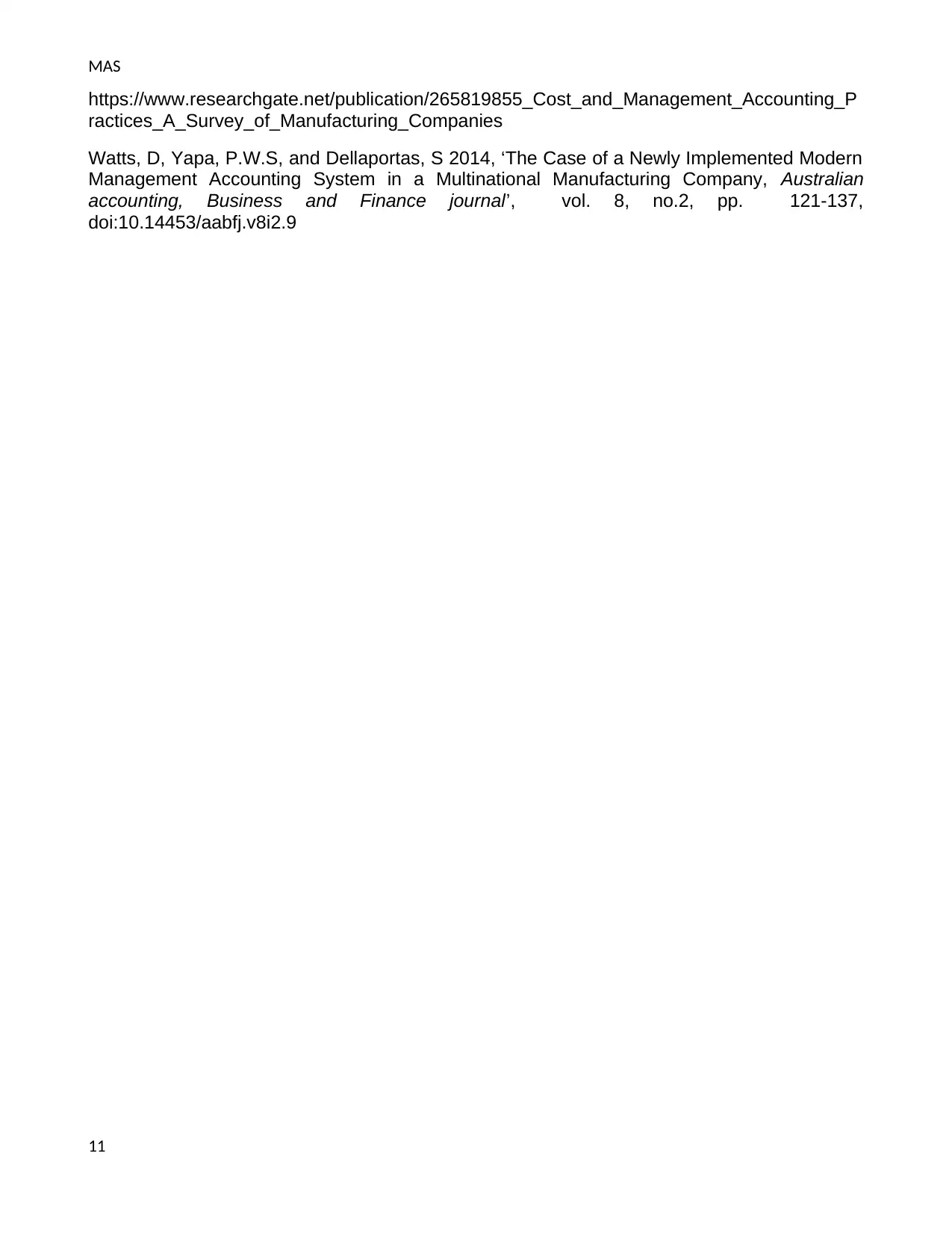
MAS
https://www.researchgate.net/publication/265819855_Cost_and_Management_Accounting_P
ractices_A_Survey_of_Manufacturing_Companies
Watts, D, Yapa, P.W.S, and Dellaportas, S 2014, ‘The Case of a Newly Implemented Modern
Management Accounting System in a Multinational Manufacturing Company, Australian
accounting, Business and Finance journal’, vol. 8, no.2, pp. 121-137,
doi:10.14453/aabfj.v8i2.9
11
https://www.researchgate.net/publication/265819855_Cost_and_Management_Accounting_P
ractices_A_Survey_of_Manufacturing_Companies
Watts, D, Yapa, P.W.S, and Dellaportas, S 2014, ‘The Case of a Newly Implemented Modern
Management Accounting System in a Multinational Manufacturing Company, Australian
accounting, Business and Finance journal’, vol. 8, no.2, pp. 121-137,
doi:10.14453/aabfj.v8i2.9
11
1 out of 11
Related Documents
Your All-in-One AI-Powered Toolkit for Academic Success.
+13062052269
info@desklib.com
Available 24*7 on WhatsApp / Email
![[object Object]](/_next/static/media/star-bottom.7253800d.svg)
Unlock your academic potential
Copyright © 2020–2025 A2Z Services. All Rights Reserved. Developed and managed by ZUCOL.





